
Concept explainers
(a)
Interpretation:
The structure for the given trivial name is to be drawn, and the correct IUPAC name is to be written.
Concept introduction:
The trivial names are commonly used names which are not systematic ones. Many trivial names are accepted by IUPAC. Nitriles are derivatives of
In naming organic compounds, the
Number the carbon chain in a way that the functional group and the substituents attached get the lowest number. The position of the functional group and substituents on the parent chain or ring is indicated by the respective locant number just before the suffix. Prefixes are used to denote the number of identical substituents. The substituents are written in alphabetical order when writing the IUPAC name.
Answer to Problem F.30P
The structure and IUPAC name for the given trivial name is
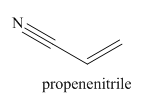
Explanation of Solution
The given trivial name is acrylonitrile.
The given name indicates that the high priority functional group is cynide. The trival name acrylonitrile correlates the derivative of acrylic acid. Structure for acrylic acid is
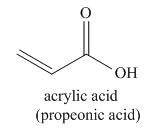
Nitriles are derived from acids where

The main chain in this molecule is of three carbon atoms thus the root name is propan, and the suffix nitrile is added to the root name. The main chain is numbered starting from the carbon atom of the nitrile group. The main chain has a C=C bond; thus the IUPAC name for acrilonitrile is propenenitrile.
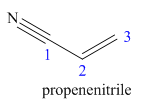
The structure for the given molecule is drawn based on the functional group, and the IUPAC named is written by adding locators to the substituents.
(b)
Interpretation:
The structure for the given trivial name is to be drawn, and the correct IUPAC name is to be written.
Concept introduction:
The trivial names are commonly used names which are not systematic ones. Many trivial names are accepted by IUPAC. Nitriles are derivatives of carboxylic acid. The trivial names of nitriles are deriving from the trivial names of the analogous carboxylic acids.
In naming organic compounds, the functional groups other than the highest priority functional groups are treated as substituents. The root name is established by identifying the longest carbon chain or a ring containing functional group. Remove the e from the normal ane, ene, or yne ending, and add the suffix that corresponds to the highest-priority functional group. Nitriles are the derivatives of carboxylic acid where
Number the carbon chain in a way that the functional group and the substituents attached get the lowest number. The position of the functional group and substituents on the parent chain or ring is indicated by the respective locant number just before the suffix. Prefixes are used to denote the number of identical substituents. The substituents are written in alphabetical order when writing the IUPAC name.
Answer to Problem F.30P
The structure and IUPAC name for the given trivial name is
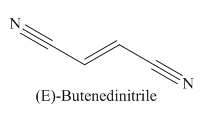
Explanation of Solution
The given trivial name is fumaronitrile.
The given name indicates that the high priority functional group is cynide. The trival name fumaronitrile correlates to the derivative of fumaric acid (dicarboxylic acid). Structure for fumaric acid is
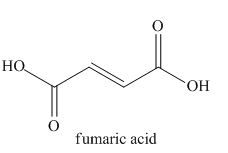
Nitriles are derived from acids where
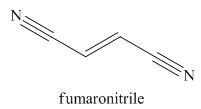
The main chain in this molecule is of four carbon atoms; thus the root name is butan. The structure has two cynide groups at both terminals; hence the suffix dinitrile is added to the root name. The main chain is numbered starting from the carbon atom of the nitrile group.

The main chain has a C=C bond; thus the IUPAC name for fumaronitrile is (E) butenedinitrile.
The structure for the given molecule is drawn based on the functional group, and the IUPAC named is written by adding locators to the substituents.
(c)
Interpretation:
The structure for the given trivial name is to be drawn, and the correct IUPAC name is to be written.
Concept introduction:
The trivial names are commonly used names which are not systematic ones. Many trivial names are accepted by IUPAC. Nitriles are derivatives of carboxylic acid. The trivial names of nitriles are deriving from the trivial names of the analogous carboxylic acids.
In naming organic compounds, the functional groups other than the highest priority functional groups are treated as substituents. The root name is established by identifying the longest carbon chain or a ring containing functional group. Remove the e from the normal ane, ene, or yne ending, and add the suffix that corresponds to the highest-priority functional group. Nitriles are the derivatives of carboxylic acid where
Number the carbon chain in a way that the functional group and the substituents attached get the lowest number. The position of the functional group and substituents on the parent chain or ring is indicated by the respective locant number just before the suffix. Prefixes are used to denote the number of identical substituents. The substituents are written in alphabetical order when writing the IUPAC name.
Answer to Problem F.30P
The structure and IUPAC name for the given trivial name is

Explanation of Solution
The given trivial name is malonitrile.
The given name indicates that the high priority functional group is cynide. The trival name malonitrile correlates to the derivative of malonic acid (dicarboxylic acid). Structure for malonic acid is
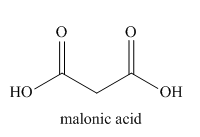
Nitriles are derived from acids where
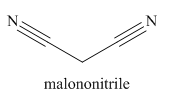
The main chain in this molecule is of three carbon atoms; thus the root name is propane. The structure has two cynide groups; hence the suffix dinitrile is added to the root name. The main chain is numbered starting from the carbon atom of nitrile group.
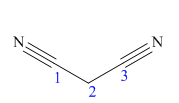
Hence the IUPAC name for malonitrile is propanedinitrile.
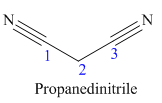
The structure for the given molecule is drawn based on the functional group, and the IUPAC named is written by adding locators to the substituents.
(d)
Interpretation:
The structure for the given trivial name is to be drawn, and the correct IUPAC name is to be written.
Concept introduction:
The trivial names are commonly used names which are not systematic ones. Many trivial names are accepted by IUPAC. Nitriles are derivatives of carboxylic acid. The trivial names of nitriles are deriving from the trivial names of the analogous carboxylic acids.
In naming organic compounds, the functional groups other than the highest priority functional groups are treated as substituents. The root name is established by identifying the longest carbon chain or a ring containing functional group. Remove the e from the normal ane, ene, or yne ending, and add the suffix that corresponds to the highest-priority functional group. Nitriles are the derivatives of carboxylic acid where
Number the carbon chain in a way that the functional group and the substituents attached get the lowest number. The position of the functional group and substituents on the parent chain or ring is indicated by the respective locant number just before the suffix. Prefixes are used to denote the number of identical substituents. The substituents are written in alphabetical order when writing the IUPAC name.
Answer to Problem F.30P
The structure and IUPAC name for the given trivial name is
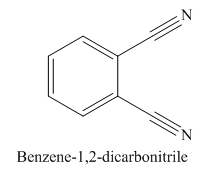
Explanation of Solution
The given trivial name is phthalonitrile.
The given name indicates that the high priority functional group is cynide. The trival name phthalonitrile correlates to the derivative of phthalic acid (dicarboxylic acid). Structure for phthalic acid is
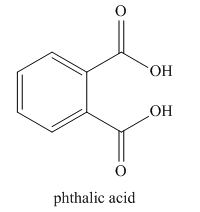
Nitriles are derived from acids where
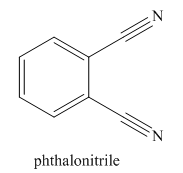
The parent ring in this molecule is benzene ring; thus the root name is benzene. The structure has two cynide groups attached directly to the ring; hence the suffix dicarbonitrile is added to the root name. The ring is numbered such that carbon atoms attached to nitrile groups get least number.
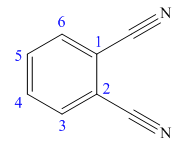
The IUPAC name for phthalonitrile is bemezene-1, 2-dicarbonitrile because two cynide groups are at C1 and C2.
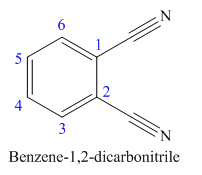
The structure for the given molecule is drawn based on the functional group, and the IUPAC named is written by adding locators to the substituents.
(e)
Interpretation:
The structure for the given trivial name is to be drawn, and the correct IUPAC name is to be written.
Concept introduction:
The trivial names are commonly used names which are not systematic ones. Many trivial names are accepted by IUPAC. Nitriles are derivatives of carboxylic acid. The trivial names of nitriles are deriving from the trivial names of the analogous carboxylic acids.
In naming organic compounds, the functional groups other than the highest priority functional groups are treated as substituents. The root name is established by identifying the longest carbon chain or a ring containing functional group. Remove the e from the normal ane, ene, or yne ending, and add the suffix that corresponds to the highest-priority functional group. Nitriles are the derivatives of carboxylic acid where
Number the carbon chain in a way that the functional group and the substituents attached get the lowest number. The position of the functional group and substituents on the parent chain or ring is indicated by the respective locant number just before the suffix. Prefixes are used to denote the number of identical substituents. The substituents are written in alphabetical order when writing the IUPAC name.
Answer to Problem F.30P
The structure and IUPAC name for the given trivial name is
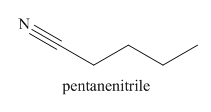
Explanation of Solution
The given trivial name is valeronitrile.
The given name indicates that the high priority functional group is cynide. The trival name valeronitrile correlates to the derivative of valeric acid. Structure for valeric acid is
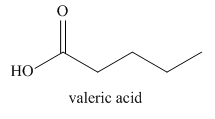
Nitriles are derived from acids where

The main chain in this molecule is of five carbon atoms; thus the root name is pentane. The structure has a cynide group; hence the suffix nitrile is added to the root name. The main chain is numbered starting from the carbon atom of nitrile group.

Hence the IUPAC name for valronitrile is pentanenitrile.

The structure for the given molecule is drawn based on the functional group, and the IUPAC named is written by adding locators to the substituents.
Want to see more full solutions like this?
Chapter F Solutions
EBK GET READY FOR ORGANIC CHEMISTRY
- Indicate the product(s) B and C that are formed in the reaction: HN' OCH HC1 B + mayoritario C minoritario OCH3arrow_forwardIndicate the product(s) that are formed in the reaction: NH-NH, OCH3 -H₂O OCH3arrow_forward21.38 Arrange the molecules in each set in order of increasing acidity (from least acidic to most acidic). OH OH SH NH2 8 NH3 OH (b) OH OH OH (c) & & & CH3 NO2 21.39 Explain the trends in the acidity of phenol and the monofluoro derivatives of phenol. OH OH OH OH PK 10.0 PK 8.81 PK 9.28 PK 9.81arrow_forward
- identify which spectrum is for acetaminophen and which is for phenacetinarrow_forwardThe Concept of Aromaticity 21.15 State the number of 2p orbital electrons in each molecule or ion. (a) (b) (e) (f) (c) (d) (h) (i) DA (k) 21.16 Which of the molecules and ions given in Problem 21.15 are aromatic according to the Hückel criteria? Which, if planar, would be antiaromatic? 21.17 Which of the following structures are considered aromatic according to the Hückel criteria? ---0-0 (a) (b) (c) (d) (e) (h) H -H .8.0- 21.18 Which of the molecules and ions from Problem 21.17 have electrons donated by a heteroatom?arrow_forward1. Show the steps necessary to make 2-methyl-4-nonene using a Wittig reaction. Start with triphenylphosphine and an alkyl halide. After that you may use any other organic or inorganic reagents. 2. Write in the product of this reaction: CH3 CH₂ (C6H5)₂CuLi H₂O+arrow_forward
- 3. Name this compound properly, including stereochemistry. H₂C H3C CH3 OH 4. Show the step(s) necessary to transform the compound on the left into the acid on the right. Bri CH2 5. Write in the product of this LiAlH4 Br H₂C OHarrow_forwardWhat are the major products of the following reaction? Please provide a detailed explanation and a drawing to show how the reaction proceeds.arrow_forwardWhat are the major products of the following enolate alkylation reaction? Please include a detailed explanation as well as a drawing as to how the reaction proceeds.arrow_forward
- A block of zinc has an initial temperature of 94.2 degrees celcius and is immererd in 105 g of water at 21.90 degrees celcius. At thermal equilibrium, the final temperature is 25.20 degrees celcius. What is the mass of the zinc block? Cs(Zn) = 0.390 J/gxdegrees celcius Cs(H2O) = 4.18 J/gx degrees celcusarrow_forwardPotential Energy (kJ) 1. Consider these three reactions as the elementary steps in the mechanism for a chemical reaction. AH = -950 kJ AH = 575 kJ (i) Cl₂ (g) + Pt (s) 2C1 (g) + Pt (s) Ea = 1550 kJ (ii) Cl (g)+ CO (g) + Pt (s) → CICO (g) + Pt (s) (iii) Cl (g) + CICO (g) → Cl₂CO (g) Ea = 2240 kJ Ea = 2350 kJ AH = -825 kJ 2600 2400 2200 2000 1800 1600 1400 1200 1000 a. Draw the potential energy diagram for the reaction. Label the data points for clarity. The potential energy of the reactants is 600 kJ 800 600 400 200 0 -200- -400 -600- -800- Reaction Progressarrow_forwardCan u help me figure out the reaction mechanisms for these, idk where to even startarrow_forward
 Introductory Chemistry: An Active Learning Approa...ChemistryISBN:9781305079250Author:Mark S. Cracolice, Ed PetersPublisher:Cengage Learning
Introductory Chemistry: An Active Learning Approa...ChemistryISBN:9781305079250Author:Mark S. Cracolice, Ed PetersPublisher:Cengage Learning Chemistry for Today: General, Organic, and Bioche...ChemistryISBN:9781305960060Author:Spencer L. Seager, Michael R. Slabaugh, Maren S. HansenPublisher:Cengage Learning
Chemistry for Today: General, Organic, and Bioche...ChemistryISBN:9781305960060Author:Spencer L. Seager, Michael R. Slabaugh, Maren S. HansenPublisher:Cengage Learning World of Chemistry, 3rd editionChemistryISBN:9781133109655Author:Steven S. Zumdahl, Susan L. Zumdahl, Donald J. DeCostePublisher:Brooks / Cole / Cengage Learning
World of Chemistry, 3rd editionChemistryISBN:9781133109655Author:Steven S. Zumdahl, Susan L. Zumdahl, Donald J. DeCostePublisher:Brooks / Cole / Cengage Learning Chemistry: Matter and ChangeChemistryISBN:9780078746376Author:Dinah Zike, Laurel Dingrando, Nicholas Hainen, Cheryl WistromPublisher:Glencoe/McGraw-Hill School Pub Co
Chemistry: Matter and ChangeChemistryISBN:9780078746376Author:Dinah Zike, Laurel Dingrando, Nicholas Hainen, Cheryl WistromPublisher:Glencoe/McGraw-Hill School Pub Co





